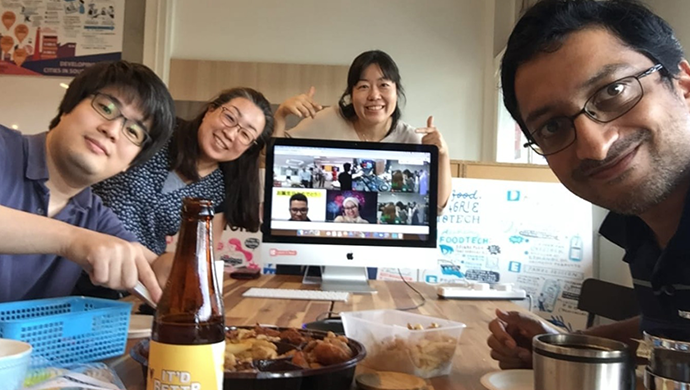
As members of the startup ecosystem, it is in our DNA to identify solutions that help improve the way we live. As disruptors are catalysts for innovation, startups keep coming up with solutions and exciting new ideas to make things faster, more efficient, and more productive for all stakeholders.
But how many of these are genuinely and positively life-changing for everyone?
With the thousands of solutions out there, do we ever think about the possibility of how many great innovations never even see the light of day because of either lack of support, being deemed too risky, and/or having inadequate resources? Which leads to the question: if you had the opportunity to solve the world’s problems, would you take it?
This is the challenge that Leave a Nest Singapore is taking on.
Advancing science and technology for global happiness
Leave a Nest Singapore was founded in December 2010 — almost a decade after its parent company in Japan was founded — with the main purpose of connecting Singapore and Japan as a first step in realising their vision of Advancing Science and Technology for Global Happiness.
As such, the company is responsible for spearheading a slew of initiatives anchored on development and innovation in several key spaces, which includes engaging financial investors and large companies seeking partnerships with innovators to be able to implement or commercialise innovative technologies.
In Singapore, Leave a Nest started with their education programme; their first big project with Science Centre in 2010 saw them starting the Science Festival and Maker Festival. Through that, they were able to bring in a Japanese company that was involved in bringing some workshops to school children in Singapore.
Also read: Leave a Nest takes innovation from research to market
The year 2014 saw the launch of TECH PLANTER, an initiative that serves as a platform for researchers and startups to develop and bring their tech out to society.
Then in 2016, Leave a Nest did a business tour that allowed them to bring in big Japanese corporates, as well as SMEs, into Singapore. This initiative also allowed them to get some funding from the Japanese government. This led them to work closely with the Singapore government in initiatives today with the Global Innovation Alliance Program.

Dr Kihoko Tokue, Managing Director of Leave a Nest Singapore
“We were starting to see some researchers who are very keen to start up their own business,” said Dr Kihoko Tokue, Managing Director of Leave a Nest Singapore “But they have no role models who address gaps in their business knowledge.”
This gap in business knowledge makes it difficult for researchers to communicate with potential VCs or investors, apart from the fact that some of these technologies — despite possessing great potential — are very risky that none of the VCs or investors would be willing to take a chance on.
With TECH PLANTER, Leave a Nest works with its corporate partners to support these emerging technologies from Southeast Asia. “We are lucky to have those corporates who shares our vision and believe in deep tech ecosystem building can result in future business through innovations,” Tokue said.
And how open are the large corporates with this exactly?
“There is of course a limitation, yet many are seeing the need to change and starting to take action to bring change,” explained Tokue. “That’s why they come to us and ask us to be a catalyst for their company.”
TECH PLANTER is just one of the many initiatives and projects that Leave a Nest Singapore spearheaded. They also work on different programmes for various partners and clients, and their approach is very much customised to what their partners need.
“Depending on what they would like to solve, what kind of thing they want to achieve, [we could develop] the programme — even the same programme that we already have and utilise it in a different way,” she added.
Also read: Here’s how you can earn passive income with cryptocurrency easily and safely
And Leave a Nest’s mission of advancing science and technology for global happiness certainly translates well with their grassroots practices: everything from education to development to building partnerships, and the occasional investment.
“We do everything from education Science workshops, training for university students, and work with deep tech startups. We do some investment from time to time, and we work with companies to do some new innovation programmes with the corporates, as well” said Tokue.
A culture of building
With all these customised programmes tailor-fitted for their partners, one would assume that Leave a Nest Singapore is a large team. But it is quite the opposite. The team is still at a growing phase with 6 members.
The secret? An ecosystem of partners ranging from incubators, accelerators, ecosystem builders, and even government officials who are willing to play their part and work together as a team for a certain initiative.
The ability to build and sustain relationships is important for Leave a Nest especially since they closely work with various stakeholders across a wide range of backgrounds to ensure that their projects and initiatives become a success. Partnerships with corporates, ecosystem builders, and government offices require the Leave a Nest team to have the skills necessary to work with diverse networks and companies.
One of the things they train their team members on is Science Bridge Communication, encompassing everything from communicating science to bridging together different parties with different backgrounds like research and business.
“Because even if they speak the same language, how they communicate is totally different. And sometimes they are talking but not really communicating. That skill is valuable everywhere and is something that we train everyone in,” said Tokue.
Being part of Leave a Nest allows members to be closely involved in projects. Working with startups means involvement with a level of dedication similar to a founding member of the company. “Team members get to see from zero to 100 of how to build a company and make it sustainable,” said Tokue.
Also read: How electric mobility startups are tackling climate change in Asia
As a startup themselves, Leave a Nest Singapore aims to create a team culture anchored in continuous building — from solutions for the benefit of Singapore and the world to partnerships that help develop these solutions and even to skills that help advance their vision.
As a company that aims to provide solutions to the issues that exist in the world, Leave a Nest is opening its doors to those who share the same goals. “If you are looking for a company to help you achieve a life mission or goal and you know that this goal cannot be achieved alone; if you want to belong to an organisation that can help achieve that goal — if you have that mindset, then Leave a Nest would be the best place to join,” Tokue concluded.
For more information, you may visit the Leave a Nest’s Singapore website or get in touch with them through their Linkedin company profile.
– –
This article is produced by the e27 team, sponsored by Leave a Nest
We can share your story at e27, too. Engage the Southeast Asian tech ecosystem by bringing your story to the world. Visit us at e27.co/advertise to get started.
The post How you can be part of solving global challenges with Leave a Nest appeared first on e27.

